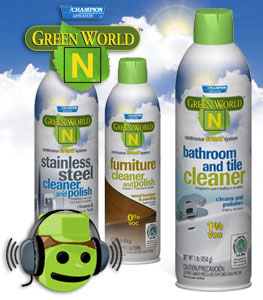

Green or Greenwashing?
Judy, your entire career has been in the aerosol industry. Has the green cleaning "explosion" been a struggle for you and your company?
I wouldn’t call it a struggle, but it has been an interesting challenge. Chase has always been concerned about environmental issues. Before green cleaning was a buzzword, for example, we responded to early warnings about CFCs in aerosols, and we’d already eliminated them from our products by the time the US EPA officially moved against them in 1978. Now, for several years, our chemists have been working with ingredients and propellants to develop even safer products.
If there was a struggle, it’s been because some other manufacturers have created their own standards and declared themselves green — that’s the ultimate in greenwashing.
That kind of greenwashing, though, made US EPA’s Design for the Environment program even more welcome in our eyes. DfE creates an even playing field, where the end user can really trust a product to be safer for people and for the planet.
So - "How" is the U.S. Environmental Protection Agency's Design for the Environment program important? And "Why?"
Let’s look at “Why” first. Public places — schools, hospitals, office buildings, all buildings — demand effective cleaners which work quickly and effortlessly. In today's environment, though, many people, particularly the very young or the elderly or those with compromised immune systems for any number of reasons, have conditions that require attention to respiratory and/or skin sensitivity. And as for Why a spray is important, it’s simply the best way to deliver many cleaning products. Sprays get into hard-to-reach crevices. There’s no measuring needed, no dilution, no spills, no buckets, no waste. A lot less training is required. So we’ve worked hard to develop a continuous-spray system, and the result is the first full line of green, DfE-certified continuous-spray products formulated for the Jan-San industry. They’re called Green World N. And the “N” is the “How.”
These continuous sprays use nitrogen (or N) as a propellant. To give you a little background, DfE evaluates the environmental and human health impacts of every chemical ingredient in a product, and allows only the safest ingredients in DfE labeled products. That reduces the use and release of about 700 million pounds of chemicals of concern each year. And it allows nitrogen, which we use as a propellant in the Green World N line, so end-users are now able to have both the convenience of a continuous spray valve and the knowledge that the DfE’s stringent criteria are being met.
What kind of continuous spray cleaners are we talking about?
The most commonly used cleaners. The ones that are used in such large volumes that they really make an impact on your surroundings, so you have to be able to trust any green claim they make. Glass Cleaner and All-Purpose Cleaner, for example. Bathroom Cleaner. Stainless Steel Cleaner, for today’s slick appliances, counters and other surfaces. And both Furniture Polish and a Dust ’n Mop Treatment. The Green World N line contains the core products everyone uses.
Do you consider Green World N and other products that carry Design for the Environment labels good examples of how to avoid greenwashing in products?
Absolutely. When “green” is important to you, don’t just take a manufacturer’s word for it. Look for the assurance of a recognized third party. US EPA’s Design for the Environment oversight is always aggressive and reliable. Chase believes in it, and we think you should, too.
For more information about Green World N and other products from Chase Products Co., including Champion Sprayon®, ProsALL® and SprayPak®, and a link to DfE, visit our website at www.chaseproducts.com.
For all things green at Chase Products Co., visit http://green.chaseproducts.com.



